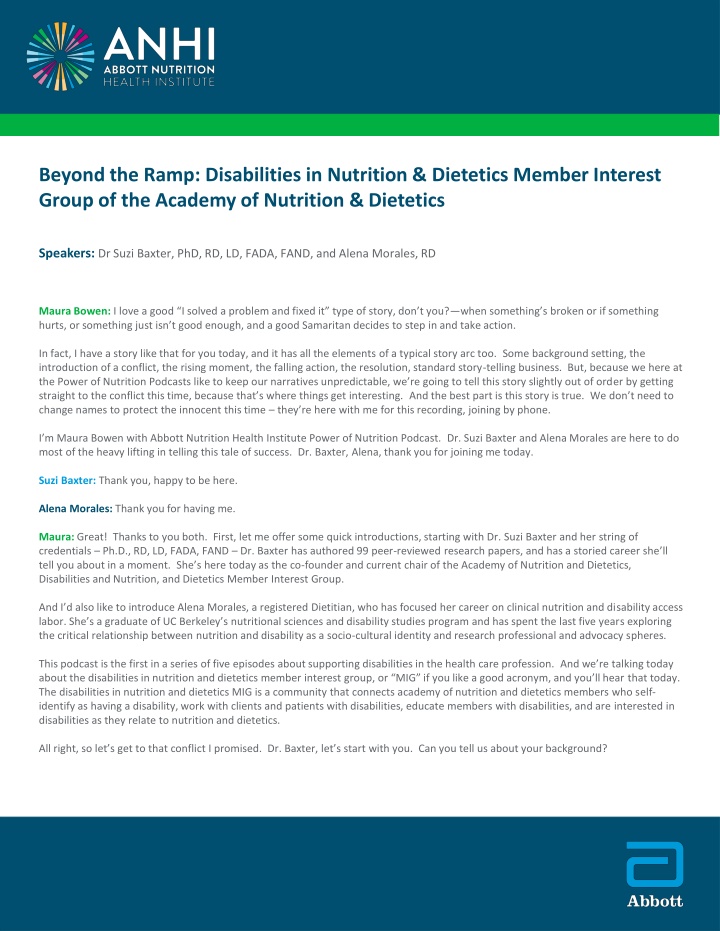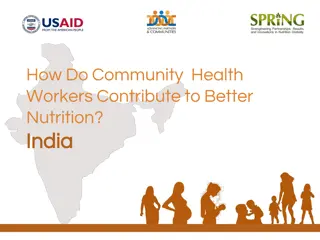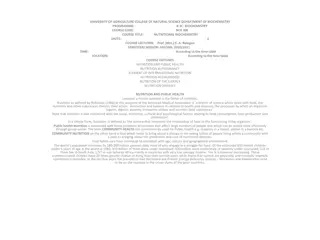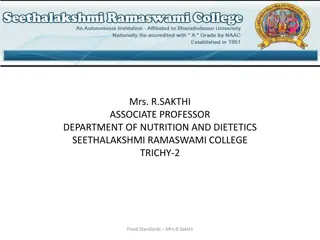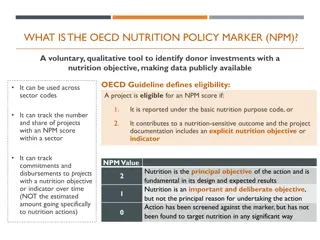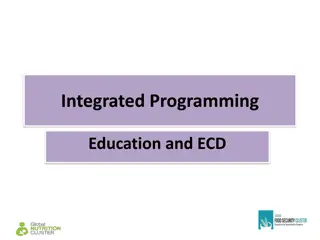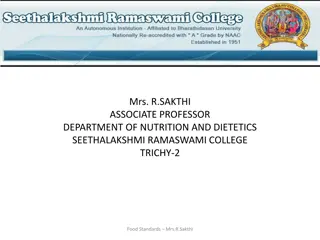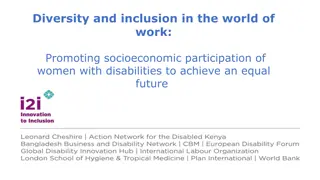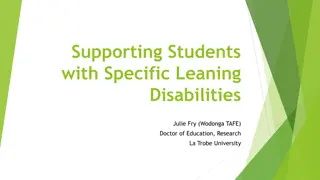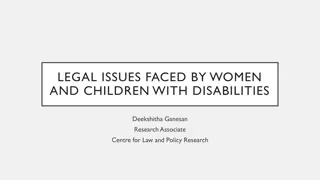Unfolding Success: Disabilities in Nutrition & Dietetics
Dr. Suzi Baxter and Alena Morales share their journey in the field of disabilities in nutrition and dietetics, highlighting the importance of the Disabilities in Nutrition & Dietetics Member Interest Group. Dr. Baxter's personal experience with Erythromelalgia adds a unique perspective, emphasizing the significance of supporting individuals with disabilities in the healthcare profession.
Download Presentation

Please find below an Image/Link to download the presentation.
The content on the website is provided AS IS for your information and personal use only. It may not be sold, licensed, or shared on other websites without obtaining consent from the author.If you encounter any issues during the download, it is possible that the publisher has removed the file from their server.
You are allowed to download the files provided on this website for personal or commercial use, subject to the condition that they are used lawfully. All files are the property of their respective owners.
The content on the website is provided AS IS for your information and personal use only. It may not be sold, licensed, or shared on other websites without obtaining consent from the author.
E N D
Presentation Transcript
Beyond the Ramp: Disabilities in Nutrition & Dietetics Member Interest Group of the Academy of Nutrition & Dietetics Speakers: Dr Suzi Baxter, PhD, RD, LD, FADA, FAND, and Alena Morales, RD Maura Bowen: I love a good I solved a problem and fixed it type of story, don t you? when something s broken or if something hurts, or something just isn t good enough, and a good Samaritan decides to step in and take action. In fact, I have a story like that for you today, and it has all the elements of a typical story arc too. Some background setting, the introduction of a conflict, the rising moment, the falling action, the resolution, standard story-telling business. But, because we here at the Power of Nutrition Podcasts like to keep our narratives unpredictable, we re going to tell this story slightly out of order by getting straight to the conflict this time, because that s where things get interesting. And the best part is this story is true. We don t need to change names to protect the innocent this time they re here with me for this recording, joining by phone. I m Maura Bowen with Abbott Nutrition Health Institute Power of Nutrition Podcast. Dr. Suzi Baxter and Alena Morales are here to do most of the heavy lifting in telling this tale of success. Dr. Baxter, Alena, thank you for joining me today. Suzi Baxter: Thank you, happy to be here. Alena Morales: Thank you for having me. Maura: Great! Thanks to you both. First, let me offer some quick introductions, starting with Dr. Suzi Baxter and her string of credentials Ph.D., RD, LD, FADA, FAND Dr. Baxter has authored 99 peer-reviewed research papers, and has a storied career she ll tell you about in a moment. She s here today as the co-founder and current chair of the Academy of Nutrition and Dietetics, Disabilities and Nutrition, and Dietetics Member Interest Group. And I d also like to introduce Alena Morales, a registered Dietitian, who has focused her career on clinical nutrition and disability access labor. She s a graduate of UC Berkeley s nutritional sciences and disability studies program and has spent the last five years exploring the critical relationship between nutrition and disability as a socio-cultural identity and research professional and advocacy spheres. This podcast is the first in a series of five episodes about supporting disabilities in the health care profession. And we re talking today about the disabilities in nutrition and dietetics member interest group, or MIG if you like a good acronym, and you ll hear that today. The disabilities in nutrition and dietetics MIG is a community that connects academy of nutrition and dietetics members who self- identify as having a disability, work with clients and patients with disabilities, educate members with disabilities, and are interested in disabilities as they relate to nutrition and dietetics. All right, so let s get to that conflict I promised. Dr. Baxter, let s start with you. Can you tell us about your background?
Suzi: Certainly. Well, first, I earned my Bachelors Degree through the Coordinated Undergraduate Program in Dietetics at Texas Christian University, and then I earned my Masters and Doctoral degrees at Texas Woman s University. But I moved to Georgia to complete a post-doctoral fellowship at the Medical College of Georgia. So, I began my career in dietetics in 1981 as the only dietitian in a residential school for children with disabilities. I also worked as an out-patient dietitian for diverse, low-income adults as a training and quality food service supervisor in the school district, and as the WIC, or Women, Infants and Children, supervisor in a public health department. For the next 25 years, I conducted nutrition research as a faculty member at the Medical College of Georgia, and then at the University of South Carolina. My primary line of research was methodological and concerned the accuracy of children s self-reported dietary recalls. I was literally at the peak of my career when I started to notice some episodic, burning pain in my hands and my feet. In 2010, I was diagnosed with Erythromelalgia, also known as burning feet syndrome. Erythromelalgia is a rare, neurovascular condition which most commonly affects the feet, but it can also affect the hands, face, or other body parts. Hallmark symptoms are redness due to excessive blood flow to the area, skin feels warm or hot, and pain which ranges from mild tingling to severe burning and is episodic. My diagnosis, took two years to confirm. Erythromelalgia has no known cure, and there s no specific medical treatment or drugs. Now, it s not fatal, but it is life-changing, because major lifestyle modifications are needed to avoid the pain triggers. And my pain seems to be triggered by things like, oh, exposure to loud environments, riding in a car, or driving a car, walking for a long time or really just more than five minutes, standing for more than just a couple of minutes, and basically, anything that puts pressure on the palms of my hands or the soles of my feet. So, I no longer can drive a car, and I even have to avoid riding in a car, except when necessary. After I was diagnosed, I continued to work for about six years. I telecommuted from home most of the time, and I arranged rides when I had to go into the office. But I just wasn t able to keep up with the workload, and so I had to resign my research professor position at the end of 2016. Maura: Thank you so much for sharing your story, Dr. Baxter. Alena, can you tell us your story? Alena:Of course, um, my experience with disability began very young about 12 years old. I developed several chronic illnesses that affected my mobility, pain, nutrition, and more. Throughout my journey, I received treatment within the health care system. During one of my hospital stays, I remember meeting a dietitian who treated me with a lot of care and humanity, and from that moment on, that was what got me into dietetics. For a few years, I mostly identified with the chronic illness community, but then I started identifying as disabled in high school when I started using a wheelchair, a central line for IV infusion, and a service dog to navigate life. I noticed that the world started treating me differently, and I started researching the disability community and its history to find others like me. I eventually came across the disability rights movement and its roots within Berkeley, California, and this required me to go to UC Berkeley for college to study dietetics and disability study. While at Berkeley, I worked for the Disability Access and Compliance Office for four years to help optimize physical, technological, and programmatic access for affiliates with disability. I also engaged in local disability activism by creating new organizations, developing nutritional wellness programs for students with disabilities, and creating one of the first disability cultural centers in the country.
Alena:My disability experience actually shifted during my junior year when I was hit by a car while in my wheelchair, and I obtained a minor traumatic brain injury. I kind of had to deal with new physical and mental obstacles, and it also reshaped my personhood and made me reimagine my disability identity to encompass a disability that was not just physical, but mental as well. In 2021, I continued my education at Berkeley by attending their clinically focused, individually supervised practice pathway or ISPP for short. I received my RD in 2022, and now I primarily work as a clinical dietitian at Palomar Medical Center in San Diego. I continue to apply my personal and professional knowledge of disability while working with patients and providing culturally competent bedside manner. Maura: Thank you both. There s a lot to think about in what we just heard, so let s unpack it, because it s one thing to experience challenges in your daily life; it s another thing to decide to make a change and to bring others along with you to everyone s benefit, and that s what the rest of this conversation is about today. So, with that in mind, Dr. Baxter, it sounds like you were learning how to adjust your life within the parameters of your new normal, and you became hyper-aware of the need for better accessibility, not just in your personal life, but in the settings, including health care, that surround you each day. So, can you tell us more about that? Suzi: Certainly, but please feel free to call me Suzi. Maura: Okay, thanks. Suzi: So, to decrease the pain episodes that were caused by walking too much, I began to use a power wheelchair or a scooter. And my wheels meant that I needed to be driven in a van with a lift, and then use a ramp to access doors to buildings. Problem was that my office was in a building with a ramp to the front door, but there was only one space for handicap parking by it. Now, the parking garage did have a ramp to the building, but that ramp was located in an unusual spot, because it came into a coffee shop on the building s ground level, and that coffee shop closed each day at 2 p.m., and the only other ramp to the building was next to the loading dock. But, when I tried that ramp, I quickly learned that it was much too steep, and I almost fell out of my wheelchair. So, I asked the university to designate more handicap parking spaces that were close to the front door. They did, but they put them on the street in front, and that street was narrow and very busy. Plus, there was no ramp from the street to the sidewalk. And then inside the building, I found that the door to the ladies restroom was very, very heavy, and I had never noticed that before, until I was in a wheelchair, so I had to ask someone to open it for me. And I often would have difficulty reaching the elevator buttons because they were blocked by large trash cans. And in airports, I find that I am frustrated by the limited number of handicap stalls and by having to wait to use them because people without disabilities are using them. Maura: Well, I can certainly understand your frustration, Suzi, and I m really sorry that these are the sorts of things that someone in a wheelchair might encounter on a daily basis, which makes me think, Alena, have your experiences been similar? You ve navigated not just your career, but your life as a student, through the lens of your disability, and I m wondering if you can tell us a little bit about that.
Alena:Yeah, I basically have identical stories as Suzi. Im not just in the university setting, but also the healthcare settings. The main difference with my experience that I kind of had to learn and grow up while having this disability identity and access to spaces intertwined with that. In middle school, I actually struggled in school because I was missing class due to appointments, hospital stays, flare-ups, etcetera I didn t even know what accommodations were until a teacher notified the school administration of my situation. And this completely changed my life. My grades went up, and I had the capacity to manage my disability alongside my schoolwork, and I felt supported in the classroom environment. But, of course, it wasn t all sunshine and roses, as my disability became more apparent and started using mobility devices. I started encountering various barriers that made me feel isolated and different as a child. And these weren t just physical barriers like Suzi had mentioned, you know, stairs just societal barriers like comments, staring, infantilization, even photos. I found myself being treated differently because I was disabled, and even the healthcare environment started to see me differently, as well. I was either too sick to receive help, or not sick enough, or too complex, or I couldn t access the types of equipment that would help give me some more answers and treatment. So, as a young person, I sort of used this as motivation to pursue knowledge in the disability community in high school., By reading about the disability rights and the disability justice movement, I realized that I wasn t the problem, but our inaccessible society was. The problem wasn t the fact that I couldn t walk upstairs the problem was that there was no elevator. And the problem wasn t that I was different the problem was that people were taught to see me differently. It s funny because when I went to Berkeley, being the birthplace of the disability rights movement, I expected it to be more accessible than it was, but I encountered barriers including that businesses were not accessible, which, at the time, I was a full power-chair user. The campus labs were too cramped to navigate, and even more programs for students with disabilities were being cut. The nutritional science building that I often attended was not accessible, so I had to enter an alternative entrance near the dumpster. And so, that, to me, kind of sent a message that disability was an afterthought to building buildings and programs, and I learned to kind of advocate for myself and others and build connection in order to increase my access, and then in, also educate others about disability. This, of course, continued through my dietetic internship and my career. I was grateful to have been accepted to Berkeley again because I had built rapport with the Director, and she was aware of my accommodation need, because the problem was that I can no longer get my accommodations through the Accommodations Office on campus, because I wasn t technically a student. There were some fights over barriers with my rotations, though, and I m sure we ll get into that in other episode, but overall, I had to utilize alternative pathways and teaching experiences to get through my internship. In my current position working at the hospital, I navigate the hospital now with primarily forearm crutches and sometimes leg braces. And this has opened some new points of accessibility for me, but it s also led to newer barriers of just planning my rounds so I m not walking too much, finding accessible parking that isn t too far away, and even more. And it s also led to its own set of othering from various people around the hospital kind of commenting on my walking and what-not. Thankfully, I feel supported by my immediate co-workers and my supervisor, though. And, of course, I could continue on and on about the barriers I ve encountered, but I also want to touch upon the positive ways in which I navigate life with a disability. I can definitely say that it s made me a better person.I ve also utilized it as an asset in my life. For example, from the moment I entered my internship to now navigating my career, I ve connected with patients with disabilities, so it felt more supported having a healthcare provider that gets it. This is and I m better able to use my experiences, both positive and negative, to kind of empathize with my patients with disabilities, as well as other marginalized identities that can intertwine with that, and for me, I feel like it s elevated my bedside manner. So, overall, navigating dietetics with a disability can be challenging, but it can be a really beautiful thing that improves the spaces that support it.
Maura: So, this is the part in the story where the audience starts to get a sense that something is about to happen that we call that the rising action and in this case, I think that s the birth of the Disabilities and Nutrition and Dietetics Member Interest Group, is that right, Suzi? Because I m hoping you can walk us through those first days of building something new. Suzi:Yes, thank you so much for asking. It started in 2016, when a dietitian colleague of mine, Neva Cochran, had been contacted by a DPD graduate with a disability to receive mentoring about writing and speaking on nutrition. Now, DPD stands for Didactic Program in Dietetics. So Neva actually asked me to join them in January 2017, and one of the first things that we thought we needed to do was to write an abstract and present it for a poster presentation. And that was accepted, so in October of 2017, at the Academy s Annual Food and Nutrition Conference and Expo or it s called FNCE for short the three of us presented the poster about the need for data on disabilities among nutrition and dietetics professionals. So, it was actually about this time, too, when I realized that the Academy really needed advocacy for disability inclusivity, as well as a formal community or group for its members with disability. And so that led me to apply, and I was fortunate to be selected, as one of four people for the Academy s Diversity LEADers Program. I learned a lot about the Academy, and that s really where I started a lot of the disability advocacy. For example, Neva and I kept inquiring with the Academy about adding disability status questions so that they could collect data on the prevalence of dietetic practitioners and students with disabilities. And so, the Academy responded by adding the disability status questions to their biannual compensation and benefits survey as of the 2019 survey. And then in October 2019, at FNCE again, Neva and I presented an educational session that was titled Individuals With Disability, Essential Members of the Healthcare Team, and in that session, we had video clips by several dietetic professionals with disabilities. Next, we published three articles about dietetic practitioners with disabilities. Then in April of 2020, I planned, and Neva moderated, a series of three free webinars. And each webinar had 200 to 300 attendees and received considerable positive feedback, so we were very pleased about that. Then in December 2020, we created the closed Facebook group for dietitians with disabilities. In June 2021, we officially submitted the Academy paperwork concerning intent to form a MIG, with Neva and myself as co-founders of the disabilities MIG. In Fall of 2020, the Academy distributed surveys so that we could obtain the minimum 75 signatures required to form a MIG, and we obtained approximately 100 signatures. And then, in March of 2022, the Academy Board of Directors approved the creation of the Disabilities MIG. We thought we had arrived, but we had another year to prepare to create our mission, vision, goals, and budget. In October of 2022, at FNCE, Neva and I had a session panel with three dietitians with a disability. It was titled Counseling for Individuals with Disabilities: Tactics from the Trenches. And, that same year at FNCE, the Academy allowed our MIG, which had not been launched yet, to have a booth at the DPG MIG Showcase booth. At that booth, we gave away clear face masks which had been donated to us. We told people these were an example of an accommodation from people with hearing impairment who rely on reading lips to understand what is being said. These clear face masks are also very helpful for healthcare practitioners and anyone else who works with children, so that children can see smiling faces, instead of masked faces. And then on June 2023, the Disabilities MIG officially launched. And it was after we launched when I learned about Alena when she applied to be a speaker for a program that we are having this Spring, and I was so impressed with her background, that I asked whether she could join me for this podcast series. Maura: Well, first of all, big congratulations on launching the MIG. And, I wanted to ask you, Alena, how did you learn about the Member Interest Group? Alena: So, I passed the RD exam in late in 2022, and when I was kind of changing my status within the Academy as a member from student dietitian, I was looking at the various DPGs and the MIGs, and I noticed that the Disabilities MIG was starting in June, and that you could reserve your spot.
Alena:And so, I joined and then in June of 2023, we started receiving forum posts, and I was kind of passively involved for a few months until I applied for the affiliate speaker grant program that Suzi mentioned, and was accepted, and this is how I kind of got to know Suzi, other than her posts on the forum, of course, and as well as other member on a more active level, and so here I am. Maura: Okay. That s great. And I want to pause for a moment to ask: why a Member Interest Group, and while you re at it, how is a Member Interest Group different from other types of other organizations for people with disabilities? Suzi: Hmm. That s a very good question. Well, the Academy has several groups that has affiliates, the Dietetic Practice Groups are known as DPGs, and then the Member Interest Groups or the MIGs. One has to be a member of the Academy in order to belong to an affiliate or to one or more of the MIGs. The Academy membership includes membership in one affiliate that you get to select. And then, as Alena mentioned, you get to pick whether you want to join one or more DPG and one or more MIG. But you do pay annual dues to join them, and that s separate from the Academy dues. The DPGs and MIGs are grouped within the Academy, whereas the affiliates are legally separate groups from the Academy. So, there is an affiliate association of the Academy for each state and each US territory, and affiliates offer education programs, annual meetings, networking opportunities, they raise funds for scholarships, and several things like that they ll do things in the community. The Dietetic Practice Groups or DPGs are professional interest groups made up of Academy members in order to connect with other members within their areas of interest or practice. So, DPGs allow the members to enhance their specialized knowledge, share practice tips, improve their job performance, and network with colleagues from around the world. Some examples of the 28 DPGs are cardiovascular, women s health, pediatric nutrition, oncology those are just a few. Whereas the Member Interest Groups or MIGs are groups of Academy members who have common interest issues or backgrounds other than their practice areas or geographic location. So, the MIGs reflect the many characteristics of the Academy s membership and the public that we serve. There currently are nine MIGs and examples are Asian Americans and Pacific Islanders, Religion, Disabilities, National Organization of Blacks, and Dietetics and Nutrition. And when Neva and I were co-founding the Disabilities group, we were asked whether we should be a DPG or a MIG. And so, Neva and I discussed it, and we really felt that a MIG would be more appropriate than a DPG. That was because we knew that we would be spanning several groups of Academy members, because dietitians with disabilities can work in a variety of settings. You might work in a hospital; you might work in a school; you might work in the community. And so, we felt that a MIG would be more appropriate, and so the Disabilities MIG includes Academy members who have disabilities themselves, who work with patients or clients with disabilities, who educate students or interns with disabilities, or simply are interested in the topic of disabilities as related to nutrition and dietetics. Maura: So, clearly, building the MIG was a massive undertaking, and I m wondering, what surprised you most about the process? So, for instance, what went better than you thought it would? What challenges did you need to overcome as you were setting up and building awareness for the MIG and so forth? Suzi: Well, that s an excellent question, and it was after we launched that more things surprised me than before we launched, and maybe that s to be expected.But it was, and it continues to be, a massive undertaking, but it s well worth the effort. And I have to share that I am a believer, and I know without a doubt that I acquired my disabilities so that my eyes would be opened, and I would begin to advocate for disabilities.
Suzi:So, some of the surprises it took seven long years to officially launch the Disabilities MIG, so that was a surprise, about the length of time. But it gave us time to advocate, which we ve continued to find that there s a lack of disability inclusivity and advocacy within the Academy. But the Academy has been very supportive in terms of both time and funding for our inaugural year. But our MIG does continue to face and overcome some bumps in the road. One example is, at our request, closed captioning is now available for all webinars offered by the Academy, DPGs, and MIGs, and we requested closed captioning for all education sessions at FNCE, and this did happen for FNCE in 2022. But, for FNCE 2023, we were expecting closed captioning for all the sessions; however, the keynote sessions were not closed captioned, but, instead, had people doing sign language, It was an issue, because many people with hearing impairment do not use sign language, but instead they rely on captions or on reading lips. And, then in several session rooms, the closed captioning did not work for all the speakers. Apparently, that was due to some type of poor internet connectivity within the conference center. We have requested that the Academy make information about accessibility more prominent to the people who register to attend, because we learned that many people were not even attending, because they thought it was not accessible. So, the Academy now is publicizing that there are special shuttle busses, with lifts, available, but they are on call for FNCE, and lifts are available at FNCE for the speakers who use wheelchairs or scooters so they can access the speakers platform. The Academy has a committee for IDEA, which is Inclusion, Diversity, Equity, and Access, and it now is addressing disabilities. We continue to advocate for digital accessibility for all websites of the Academy and the Commission on Dietetic Registration, and I ll talk more about digital accessibility for a later podcast in this series. Maura: So, now that you have an established organization, can you tell us a bit about your current member enrollment and about the dynamics of the group? Suzi: Oh, certainly. Well, we are very excited that we have 240 members to date. We re also excited that about 59 percent of those are active members of the Academy; eight percent are retired members; and 30 percent almost one-third are student or intern members. And our members come from across the nation, basically from 40 states in the United States, and our most common practice areas are clinical, community public health, education, consultant, research, business industry, management, and not currently or self- employed. We have an executive committee leadership team that includes seven elected members and then 19 appointed leaders, and we ve had great response from our members stepping forward and being willing and interested in taking on a leadership position, so we feel very fortunate and very blessed and we re very excited about it. Maura: Well, that s incredible, especially considering that the MIG just launched in June of 2023, so very well done. And I think it might help our listeners to hear a little bit more about what the MIG is currently working on, and any specific impact you d like to highlight, and it s okay to boast a little bit we do love to highlight great work on this podcast, so let s hear it. Suzi: Certainly. Thank you. We have a grant funded by the National Center on Health, Physical Activity, and Disability that acronym is NCHPAD. And with that grant, we offered a disabilities MIG Affiliate Speaker Grant Program this fiscal year. Now, when the Affiliates applied, they were provided with the link for a guide about planning and conducting accessible conferences. And then on their applications, they had to explain how they would make their annual conference accessible. And we have funded five Affiliates to receive one of these speaker grants, so they will have a member from the disabilities MIG speak at their annual conferences, and Alena is one of our speakers she s actually speaking at two of our annual conferences.
Suzi:We will have an exhibit for the four of the five annual conferences that are held in person instead of visual. And that, these exhibits, we will have information about the Disabilities MIG and NCHPAD, who funded the grant. We ll also have adaptive kitchen tools and utensils, which can help people with disabilities prepare and eat food independently. So, we re very excited about them. We also have another project an unofficial project because a goal of our MIG is to help potential practitioners, students or even people in high school before they re even entering college, to recognize that a career in dietetics is possible, even with a disability. So, our unofficial project is to self-publish a book that features brief autobiographies of credentialed dietetic practitioners with a disability; for example, they ll share their experiences attending college with a disability, completing their internship, passing their registration exam, getting a job those things, as well as things concerning food like shopping, preparing, and eating food with a disability. And we have many wonderful dietitians and diet techs from various races, ages, and genders, who work in various settings and they have various disabilities. And then, something else that we are actually hoping to have we re in the planning stages now and we re looking for sponsors to help fund this: we want to bring an accessibility awareness lab to FNCE this October 2024, which will be held in Minneapolis. This accessibility awareness lab is not to simulate what it is to have a disability, but, instead, is to increase your awareness and, thus, increase your empathy for people with disabilities and help people realize that it s not the disability that s the problem, it's the barriers in our environment that are the problems. Maura: Well, that s great, and that sounds like three excellent and really important initiatives that the MIG is wrapping its head around already, so thank you for sharing those. You talked a lot today about how important it is to bridge the gap in resources available to apply to the field of dietetics, and I m wondering, where do you think those gaps are being filled so far, and where do the gaps still exist? Suzi: That s an excellent question. Well, some of the gaps are being filled, but there are other gaps that remain. One example is that several of our members with vision impairment have shared with us is that they cannot enter their continuing education activities in their online learning plan and activity log, and this is something that s required for credentialed practitioners. Now, in hindsight, I realize that we need to take responsibility for part of this too, because we should have done a better job when we reported those issues to the Academy by including specific examples of how and why they could not access that plan and complete it. Now the disability community does have a motto: nothing for us without us, and that motto basically means that it s always best to involve people with disabilities, for example, when you re making accommodations. So, as I maybe hinted to earlier, but I want to come out and say it now, that if you or your immediate family members don t have disabilities, then disabilities probably are not on your radar screen at all. But once the disabilities are on your radar screen, you become so much more aware, and you learn so much more about them and about the accommodations and barriers in the environment. Another example concerns the stipends, or pay, for LEADers or executive committee members of groups to attend annual conferences of an organization. When that can get a bit tricky is when the leaders have disabilities, and the disabilities can prevent them from traveling. For example, travel is very hard on me, and the only way I am able to manage it now is just my husband comes with me so that he can help me. But, for many people with disabilities, travel is out of the question. It can be very tiring and just very difficult to navigate the different spaces. The stipends are the pay that s offered to the LEADers to attend. Could there be some flexibility, so that, if there s a virtual route or recordings of the sessions that the stipend or the pay could be used for the LEADers with disabilities to attend virtually, or to listen to recordings after the session? Some type of flexibility for that is very helpful, and it allows the people with disabilities the LEADers with disabilities to still be included. And so, instead of referring to these things as gaps, I try to refer to them as opportunities and be positive about it. We continue to have numerous opportunities to promote disability inclusivity and accessibility.
Maura: All great points. And Alena, I wondered if you have anything you wanted to add? Alena:Yeah, I have a couple of thoughts. I completely agree with Suzi that there are numerous opportunities to address gaps. Overall, I think gaps can be found everywhere in any career field, especially dietetics, where there s a lot of different faces and environments and purviews that dietitians can have, and other credentialed practitioners can have. Overall, I think the visibility of disability in itself, elevating the culture of disability and elevating the work that existing practitioners with disability, they re doing, is really the essential piece to get the momentum going about inclusivity and elevating patient care and increasing accessibility to this field. In my opinion, I think that the Disability MIG, in itself, is really this inaugural opportunity to formally gather dietetic practitioners, students, interns with disabilities in this communal space where we can share our experiences and our ideas to make the dietetics profession more equitable. Maura: Well, this was excellent, and I want to give kudos to you both, because it s a real hero s tale to meet a challenge head on and make a difference the way you have. So, congratulations on getting the MIG started, and best wishes as you continue to build momentum across the program. And I also wanted to end by saying that every good tale has a moral, right? And in this case, you can make things better for yourself and for other people when you care enough to step up and lead. And you ve heard all about that today. So, I wanted to end on the question: where can people learn more and how can they get involved? Suzi: Thank you for asking that. You can simply do a search on Disabilities MIG. Our website is www.disabilitiesmig.org, and that will tell you more about us; it will tell you how you can join; our dues are very low and nominal, like $5 for students or interns and $10.00 for active members. The retired members get to pay the student or intern rate of $5.00, so our dues are quite low. We made the dues low so that people would join and that that would not be a barrier in and of itself. But we are finding that we need to attract sponsors so that we can fund the different things that we want to do, because our dues will not be self-sustaining. Maura: Well, thank you both. Incredible job today, and I hope you ve settled in, because we have four more episodes to record together. Do you think you re up for it? Suzi: Yes, certainly. Alena: Absolutely. Maura: Definitely. I m glad to hear it. So, in our next episode, we ll talk about building an accessibility culture in environments for clinicians, students, and interns with disabilities, and I m really looking forward to it based on today s discussion. Now, for our listeners, if you re looking for more podcasts, we have dozens and dozens across a variety of different nutrition science topics, and you find them on ANHI.org by clicking Resources at the top of the page, and then podcasts. And hey, we re no strangers to the need for transcripts for our recordings, so you can find those sitting side by side with each episode when you access them from our site. We re also on Spotify and Apple podcasts if that s where you like to take your listening, so please be sure to subscribe to ANHI s Power of Nutrition podcast series to hear the latest nutrition science news and share us with your colleagues. Thanks everyone, and we ll talk to you next time.
